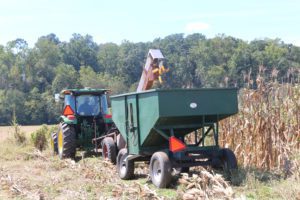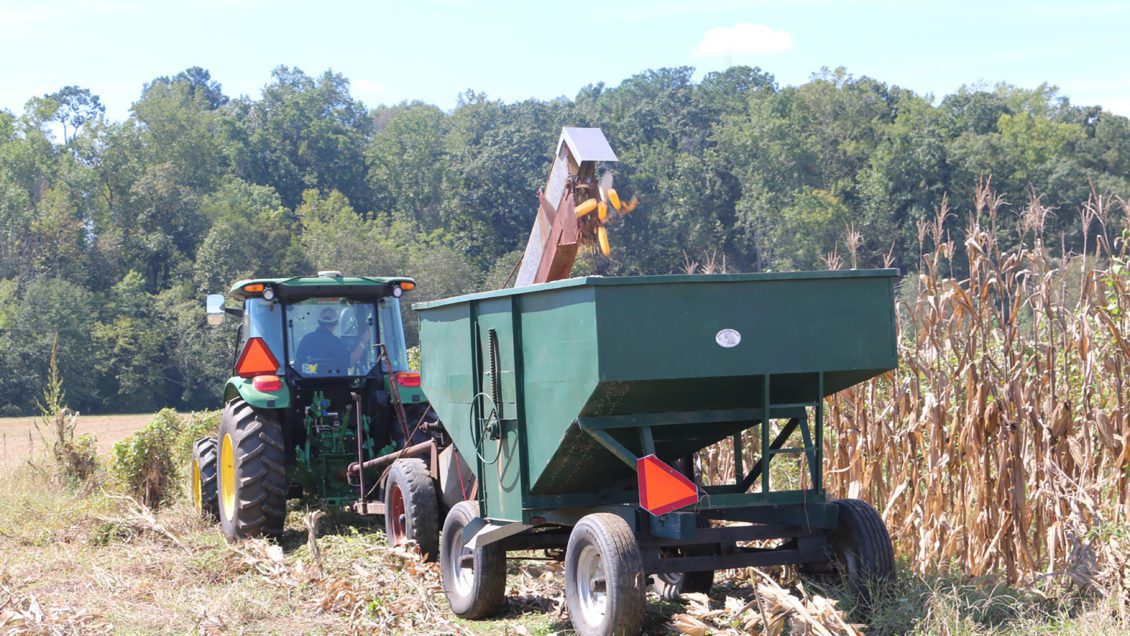Corn harvest is underway and soybean harvest will soon begin in South Carolina. To help farmers when making decisions related to storing or field drying grain crops, Clemson University has a new app.
The app is the Clemson EMC Calculator, developed by Clemson’s Department of Agricultural Sciences and Precision Agriculture group to help farmers optimize moisture content of stored grain and help evaluate field drying grain.
Equilibrium Moisture Content (EMC) is the moisture content grain will attain if exposed to a specific relative humidity and temperature for a long enough duration. Given enough time, grain moisture will come to match the temperature and relative humidity in the air around it. EMC calculations are used to determine best drying conditions.

“Knowing the EMC is useful for estimating the moisture content of grain in storage, determining the lowest moisture content that can be achieved for given conditions and analyzing drying processes,” said lead developer Aaron Turner, assistant professor in the Clemson agricultural mechanization and business program.
EMC also can be used as an indicator of how grain moisture will change. If EMC is lower than grain moisture content, drying will occur. If EMC is higher than the current moisture, rewetting occurs, although much slower than drying.
The Clemson EMC Calculator can predict how EMC will change using the 5-day weather forecast from OpenWeatherMap.org. This is useful when making decisions involving natural air drying, where fans and air are used to condition the grain.
“The goal is to cool and dry the grain to reach safe storage conditions and to preserve quality,” Turner said. “When using natural air drying, heat and moisture are transferred from the grain to the air being blown through the bin.”
Traditionally, farmers have been advised to continuously run fans until the drying front moves all the way through the grain. But recent research has shown intermittent fan operation works in some situations.
“This can prevent warming the grain, rewetting and can help save electricity,” Turner said. “This tool can help identify periods when the air would be productive to either cool or dry the grain, which would be useful for someone who is interested in manual fan scheduling.
“The initial motivation behind this was to reduce fan runtime while still maintaining manual control of when the fans cycle on and off.”
There are some rules of thumb for when to run the fans and even some automated systems that automatically control the fans. Generally, mold growth is suppressed when grain moisture is low enough so the relative humidity in the grain pore spaces is less than 65% and insect activity is greatly reduced when the temperature is less than 40 degrees.
Drying time depends on moisture content, ambient conditions, and airflow. Turner suggests checking with equipment dealers to ensure the fans provide enough airflow for the bin (about 2 cubic feet of air per minute/bushel, or 2 cfm/bu). Additionally, coring and leveling a bin before drying improves drying uniformity. Once the grain is dry, check the grain condition frequently and use good aeration practices to help reduce moisture migration. A final suggestion is to use temperature and/or moisture cables to monitor the drying process and conditions in storage.
In addition to being used after harvest, this calculator also can be used by farmers who are field drying. The same weather forecast can give an indication of the drying potential and how grain moisture will change in the field.
“Generally, the bigger the difference between the current moisture and EMC, the more drying potential there is,” Turner said. “The assumption is that during an extended field drying period, grain moisture will fluctuate with EMC.”
This free app can be found at https://precisionag.sites.clemson.edu/Calculators/Grain_Storage/EMC_Calc/.
To calculate EMC for a single set of conditions, just four inputs are required — temperature, relative humidity, crop and model. The calculator utilizes standardized relationships provided by American Society of Agricultural and Biological Engineers to estimate EMC.
Several models have been proposed to represent this relationship, and the calculator allows users to select between them and see changes in the results. Farmers who don’t have a preference as to which model they use should use the composite option, which is the default.
“The composite option takes the average of all the models,” Turner said.
The calculator also can help with ambient air EMC forecasting. Inputs required are Zip code, crop and model. Again, farmers who don’t have a model preference should use the composite option.
Kendall Kirk, a Clemson precision agriculture engineer housed at the Edisto Research and Education Center in Blackville, South Carolina, said he was “marginally involved,” adding Turner and doctoral student Brennan Teddy from Shelby, North Carolina, did most of the work.
“There are other EMC calculators out there, but what sets Aaron’s apart is the forecasting capability, which can really help with on-farm management decisions and planning,” said Kirk, adding the app distinguishes itself from many others as being simple to use and intuitive.
The EMC Calculator is one of several free, web-based apps from Clemson Precision Agriculture. These apps are accessible from just about any device with a web browser and can be found at https://www.clemson.edu/extension/agronomy/PrecisionAgriculture/calculators/. For more information, contact Aaron Turner at apturne@clemson.edu.
-END-
Get in touch and we will connect you with the author or another expert.
Or email us at news@clemson.edu

